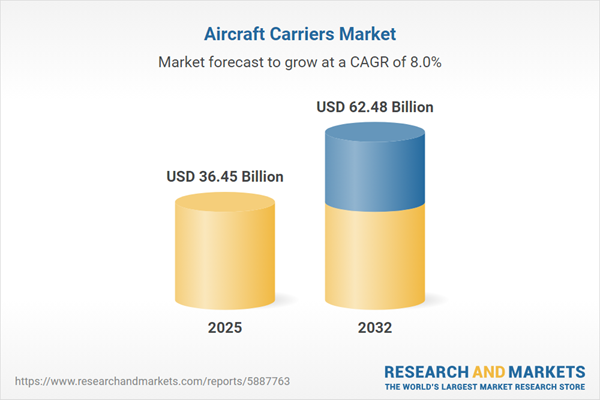Speak directly to the analyst to clarify any post sales queries you may have.
The aircraft carriers market is reshaping global naval priorities as defense organizations seek agile capabilities to address evolving security requirements. Market dynamics are characterized by rapid modernization and adaptive strategies vital for operational readiness.
Aircraft Carriers Market Snapshot
The global aircraft carriers market is projected to expand from USD 33.69 billion in 2024 to USD 36.45 billion in 2025, reaching USD 62.48 billion by 2032 at a compound annual growth rate (CAGR) of 8.02%. This market’s growth is propelled by increased geopolitical tensions and a strong focus on strategic modernization. Rising competition and high-value investments have intensified efforts to renew fleets and deploy next-generation shipboard technologies. Navy and defense leaders worldwide demand advanced capabilities, underscoring the importance of data-driven, adaptive decisions. Organizations navigating shifting security landscapes must respond swiftly to evolving threats and procurement cycles to maintain leadership and operational effectiveness in a changing defense environment.
Scope & Market Segmentation
This comprehensive report gives senior decision-makers a clear understanding of the current and future-state aircraft carriers market. Actionable insights address both immediate sector challenges and long-term opportunities, empowering robust strategic planning and investment decisions across the defense value chain. In-depth segmentation and regional assessments help focus priorities and uncover opportunities for differentiation within vital international hubs.
- Platform Types: Catapult-assisted (Catobar), ski-jump-assisted (Stobar), and short takeoff vertical landing (Stovl) carrier platforms adapt to regional requirements, supporting varied mission profiles and integrating into multi-theater naval operations.
- Material Types: High-strength steel is the basis of hull design, while advanced composites such as carbon fiber and Kevlar enhance stealth, durability, and survivability. Choosing optimal materials impacts radar signature management and long-term vessel sustainability.
- Regional Outlooks: Analysis spans key regions including the Americas, Europe, Middle East & Africa, and Asia-Pacific. Major nations like the United States, United Kingdom, France, China, India, Brazil, Japan, and Australia set benchmarks in fleet modernization, influenced by defense alliances, regulations, and industrial capabilities.
- Key Industry Players: Leading organizations—such as Huntington Ingalls Industries, China State Shipbuilding Corporation, JSC United Shipbuilding, Naval Group, BAE Systems, Fincantieri, Mitsubishi Heavy Industries, Hyundai Heavy Industries, Navantia, and Mazagon Dock Shipbuilders—prioritize research and development, foster innovation, and cultivate strategic partner relationships to advance operational capability.
Key Takeaways for Senior Decision-Makers
- Modern carrier platforms are being designed for seamless integration with multi-domain naval task forces, providing commanders expanded operations flexibility.
- Implementation of modular vessel construction supports rapid adaptation to mission changes, reducing refit times and facilitating ongoing evolution as priorities shift.
- Deployment of unmanned aerial systems from advanced carriers strengthens intelligence, surveillance, and reconnaissance capacities across contested maritime regions.
- Use of advanced composites streamlines maintenance and extends vessel lifespans, aiding in long-term fleet management and sustainability planning.
- Regional shipbuilding clusters align modernization efforts with alliance strategies, ensuring timely responses to shifting security demands and fortifying defense readiness.
- Manufacturers, technology partners, and research bodies collaborate to accelerate digital integration, enhancing supply chain reliability during periods of global disruption.
Tariff Impact on Supply Chains
Evolving trade policies and the imposition of new protective tariffs are reshaping supply chain management strategies for the aircraft carriers market. Leading manufacturers respond by strengthening domestic sourcing practices, diversifying vendor relationships, and building adaptive frameworks. This proactive approach minimizes production delays and sustains continuous operations despite regulatory shifts.
Comprehensive Methodology & Data Sources
This research integrates perspectives from shipbuilders, naval engineers, material specialists, and defense executives to guarantee rigorous findings. All outcomes are cross-verified against credible open-source databases, offering senior leaders reliable benchmarks for procurement choices and future investments.
Why This Report Matters
- Enables benchmarking of modernization and procurement strategies, tailored for defense and naval executives driving transformation efforts.
- Strengthens supply chain resilience and improves lifecycle management, ensuring organizations remain agile within dynamic regulatory and geopolitical environments.
- Provides focused intelligence on key technologies and emerging partnerships, empowering proactive risk management and strategic positioning in a competitive landscape.
Conclusion
Data-driven market intelligence empowers senior leaders to optimize resources and synchronize strategic objectives with new trends and transformative developments throughout international naval defense.
Additional Product Information:
- Purchase of this report includes 1 year online access with quarterly updates.
- This report can be updated on request. Please contact our Customer Experience team using the Ask a Question widget on our website.
Table of Contents
3. Executive Summary
4. Market Overview
7. Cumulative Impact of Artificial Intelligence 2025
Companies Mentioned
The companies profiled in this Aircraft Carriers market report include:- Huntington Ingalls Industries, Inc.
- China State Shipbuilding Corporation Limited
- JSC United Shipbuilding Corporation
- Naval Group
- BAE Systems plc
- Fincantieri S.p.A.
- Mitsubishi Heavy Industries, Ltd.
- Mazagon Dock Shipbuilders Limited
- Navantia, S.A.
- Hyundai Heavy Industries Co., Ltd.
Table Information
| Report Attribute | Details |
|---|---|
| No. of Pages | 193 |
| Published | October 2025 |
| Forecast Period | 2025 - 2032 |
| Estimated Market Value ( USD | $ 36.45 Billion |
| Forecasted Market Value ( USD | $ 62.48 Billion |
| Compound Annual Growth Rate | 8.0% |
| Regions Covered | Global |
| No. of Companies Mentioned | 11 |









